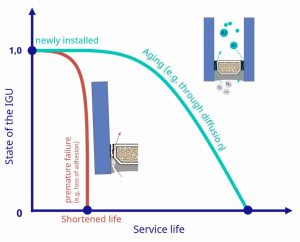Avoiding failure: Specifying insulating glass for lifetime
by brittney_cutler | December 29, 2021 1:27 pm
 [1]
[1]By Helen Sanders, Ph.D.
Building lifetime and building components’ service life are often-overlooked drivers of low-carbon design. Replacing components frequently compounds embodied carbon emissions, and operational carbon performance is only as good as their lifetime.
Insulating glass units (IGUs) are key building envelope components. Replacing single-pane glass to reduce operational carbon emissions also means glass with a 1000-year lifetime is replaced by an IGU with a 25- to 30-year lifetime. Increased embodied carbon has been traded for reduced operational carbon emissions.
Since the operational carbon and comfort benefits of IGUs are needed, the focus should be on specifying material to maximize their lifetime. Several factors affect an IGU’s lifetime:
• Edge seal material choice and design;
• Climate stresses and other application-specific loads;
• Manufacturing quality; and
• Installation quality and conditions
Edge seal material specification is critical. Dual-seal polyisobutylene (PIB)/silicone systems are ubiquitous in commercial applications because of silicone’s water- and ultraviolet (UV)-resistance and structural strength. Since silicone does not provide a gas or vapor barrier, a high-quality spacer with excellent barrier properties is important as there is no back-up. Ensuring excellent adhesion to the spacer is also crucial to prevent failures due to water pooling next to the PIB, spacer movement (for flexible systems), and over-extension of the PIB.
For these reasons spacer with solid metal vapor barriers—like aluminum, stainless-steel, and plastic hybrid stainless steel (PHSS) box spacers—serve as the benchmark for IGU durability. PHSS warm-edge spacers have the added benefit of matching non-metal spacers’ high thermal performance. It is tempting to incrementally reduce spacer system thermal conductivity by replacing the metal vapor barrier with plastic metalized films. When compared to PHSS spacer, this has a minor effect on the fenestration assembly U-factor, when simulating the appropriate sealant height. However, removing the metal barrier brings greater risk to service life, especially when used with silicone secondary sealant.
Loads on the edge of the glass caused by temperature and barometric pressure changes, and wind loads, causing IGU cavity pressure variations, can elongate the PIB. The higher the PIB elongation, the greater vapor and gas permeation, and the higher risk to service life. This can be mitigated with application-specific edge seal analysis, although this is rarely done.
Triple-pane IGUs are at a comparatively higher risk for high edge loads than dual-pane units because of their larger effective cavity. Controlling seal quality is also more difficult when manufacturing triple-pane glazing because two seals are not visible for inspection. Since the third pane also adds 50 percent more embodied carbon, a holistic view of operational carbon, embodied carbon, and service life should be employed during fenestration design and specification.
It may be possible to achieve the desired thermal performance without triple-pane glazing using wider thermal barriers in the frame, PHSS spacer, and/or a fourth-surface low-e in a dual-pane instead. These alternatives are low-embodied carbon solutions with low-risk to service life.
Manufacturing quality can be managed by specifying fabricators who make IGUs under robust certification programs like the IGCC®/IGMA® and IGMAC programs. Specifying contractors certified through the NACC program further supports a quality installation.
 Helen Sanders, Ph.D., is a general manager at Technoform North America. She has more than 25 years of experience in glass technology, market development, and manufacturing, especially in functional coatings, insulating glass, and thermal zone technology for fenestration. Sanders has a doctorate in surface science from the University of Cambridge, England and is an active member of many industry organizations and in codes and standards development. She can be reached at helen.sanders@technoform.com.
Helen Sanders, Ph.D., is a general manager at Technoform North America. She has more than 25 years of experience in glass technology, market development, and manufacturing, especially in functional coatings, insulating glass, and thermal zone technology for fenestration. Sanders has a doctorate in surface science from the University of Cambridge, England and is an active member of many industry organizations and in codes and standards development. She can be reached at helen.sanders@technoform.com.
- [Image]: https://www.constructionspecifier.com/wp-content/uploads/2021/12/Fig1_Technoform_ServiceLife_June2021.jpg
Source URL: https://www.constructionspecifier.com/avoiding-failure-specifying-insulating-glass-for-lifetime/